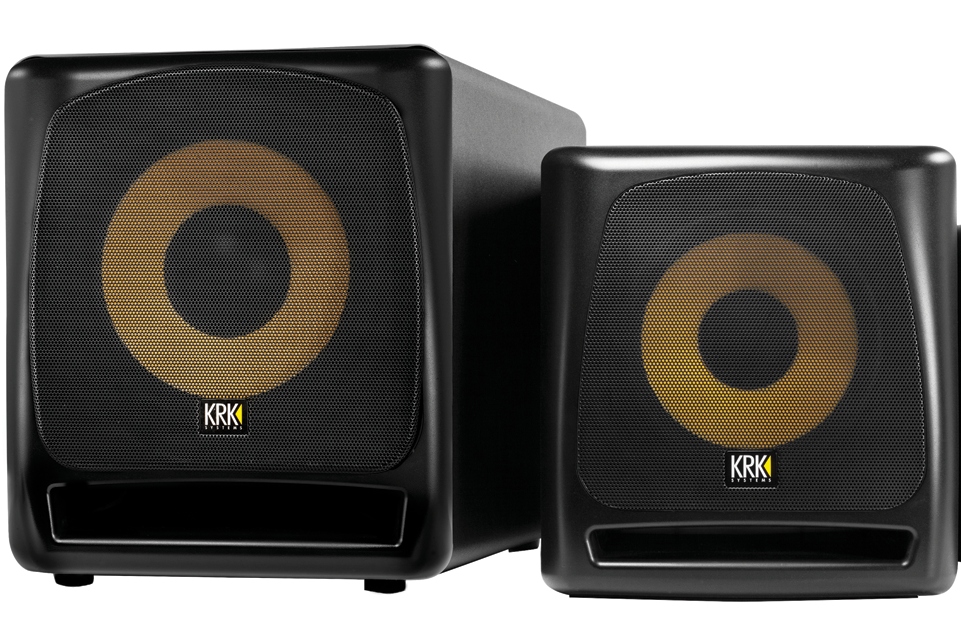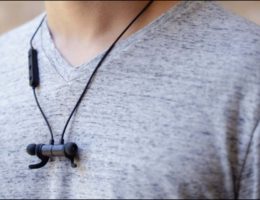One question I frequently see people asking is: which of two KRK subwoofers is better? 10s or 12s? Is the 12s worth the extra money, or should you stick with the medium-level 10s? The truth is, there is no “right answer” when it comes to the KRK 10s vs 12s debate. But there are some people who will probably do better with one, rather than the other. Today I’ll talk about which one might be right for you, and why.
In a Hurry?
Both of the KRK subwoofers are on their second generation. The originals came out a few years back, and in the intervening time, KRK Systems has updated and improved their equipment. Both the 10s and the 12s have withstood the test of time, and they’re each excellent choices for achieving high-quality low-frequency extension.

The whole line of KRK subwoofers starts with the KRK 8s at the low end. That’s the smallest of the three, but for me, the most interesting options are the KRK 10s and the KRK 12s. You get more power from each of them, and the differences are also more pronounced. The 8s is basically just like a little version of the 10s. If you’re going to get one, you may as well get the 10s. But the 12s is significantly larger, heavier, and pricier. It also delivers a fuller sound, so the question is: is that worth it to you? Just how much studio subwoofer do you need?
What Does a Subwoofer Do?
It’s not always realistic to rely on your speakers or studio monitors to do everything. When you’re in a professional studio, you might have access to speakers that have a very wide range. But in most cases, if you want to really experience the bass and low end your tracks, you’ll get the best results from a subwoofer. This is especially true if you’re in a home studio, without a full professional setup.

Many commercially available speakers will have a good range on the high end of what we can hear, but not on the low end. The result is that when music is replayed, that upper range comes through loud and clear, but the bass is cut out. Or it’s quiet, or distorted. While a speaker or studio monitor can get down to about 40Hz, a subwoofer will be able to produce low frequency down to about 30Hz. According to KRKs stats, the 10s lends bass extension to 28Hz, while the 12s gets you down to 26Hz.
The KRK Brand
KRK has been in business for a long time, and they’re widely respected for the quality and durability of their products. They take a lot of care in creating their equipment and producing something that will please customers in real-world scenarios.

This line of KRK subwoofers is pretty versatile and can be hooked up to most studio monitors or speaker systems. In terms of how the subwoofers look, they’ll fit right in with other KRK monitors, like the KRK Rokit 8, the v-series nearfield monitors, or their VXT line.
KRK 10s vs 12s: At a Glance
First off, let’s get a very basic introduction to these two subwoofers, so we know just what we’re talking about.
KRK 10s

The KRK 10s is a 160-watt active subwoofer, with a 10-inch glass aramid composite woofer. It weighs roughly 35 lbs, provides bass extension down to 28Hz, and tops out with a maximum SPL of 117 dB.
The 10s is a 10-inch glass-aramid composite studio subwoofer. For the record, the Kevlar used in the 12s is a specific brand of aramid, so they’re not totally different substances. But the glass composite is not quite as hardy.
Basic Specs of the KRK 10s
- 10″ glass aramid composite woofer
- Bass can go down to 28Hz
- Reported Frequency Response of 34Hz – 130Hz
- Max Peak SPL of 117 dB
- HPF bypass footswitch control allows you to control the sub and crossover filter
- Optional high-pass filter bypass
- Front-firing bass port
- Class D amplification
- Ground lift controls
Check KRK 10s Price on Amazon
KRK 12s

Just to be clear, when we talk about the 12 in this article, we’re specifically talking about the 12s. KRK also has the 12sHO, which is the much pricier 12 “High Output” woofer, but that’s not what we’re referring to here.
The KRK 12s is a 220-watt active subwoofer, with a 12-inch woven kevlar woofer. It weighs about 66 lbs, and gives your bass extension to 26Hz, with a max SPL of 119dB.
Basic Specs of the KRK 12s
- 12″ Kevlar woofer
- Bass can go down to 26Hz
- Reported Frequency Response of 32Hz – 139Hz
- Max Peak SPL of 119.9 dB
- HPF bypass footswitch control allows you to control the sub and crossover filter
- Optional high-pass filter bypass
- Front-firing bass port
- Class D amplification
- Ground lift controls
Check KRK 12s Price on Amazon
Side by Side
So right here, we get a little bit of an idea of the difference between these two. What’s interesting is that the 12s isn’t that much louder than the 10s, but it does give you a little more extension on the low end.
Another thing that probably leaps out is the difference in materials. The KRK 10s (like the KRK 8s) is made of a glass aramid composite. That’s strong, but the woven kevlar in the 12s is an extra level of durability (there’s a reason they make bulletproof vests out of kevlar). The tradeoff is the weight. The difference in size and materials used makes the 12s considerably heavier than the 10s or 8s.
When you get right down to it, many of the components and features are the same. The main difference is in the materials used and the range of available sounds.
What About the KRK 8s?

You might ask why I’m not including much about the smallest subwoofer (KRK 8s) in this review. It’s because the price and size difference between the 8s and 10s isn’t that much. Right now, on Amazon, the 10s is listed around $400, while the 8s is around $350. Obviously, that may change after posting. But if you’re already spending this amount on a subwoofer, you may as well get a 10s. It gives you a max SPL of 117 instead of 112, and a low range of 28Hz instead of 30. The only major difference is that the KRK 8s is a little lighter at 26 lbs, so it’s slightly more portable.
Check KRK 8s Price on Amazon
The Price Jump
The price difference between the 10s and 12s is much more significant. The real question is whether or not the 12s is worth the extra price hike. Is the improved sound, frequency response, and volume really worth it? Let’s take a look at each of the two woofers to see what they offer.
Build Quality and Style

The build quality for the 10s is really solid when you take a close look at it. It comes with a great MDF enclosure to dampen unwanted sounds. You don’t want any extra vibration that isn’t part of the sound you’re generating.
Materials and Shape
Using the wrong materials for your enclosure would muddy the sound. High-quality speakers and woofers use MDF (Medium Density Fiberboard). This is a wood-resin composite that soaks up extra energy and gives you a clearer result. The 10s definitely delivers in terms of materials, as well as aesthetic and shape.
Both woofers are built to take some wear and tear. The KRK 10s is made of a strong casing and rounded edges, which look stylish but also take bumps and blows better than sharp edges sometimes do. The curved edges both reduce phase incoherence and give the woofer a pleasing look.
The 12s has its 12-inch Kevlar driver, and both the 10s and 12s come with a removable mesh grille for added protection. They’re both durable and built to last.
Weight
In practical terms, the weight does make a bit of difference. The difference between 30 lbs and 60 lbs is significant, especially when dealing with something large and unwieldy like a speaker or woofer. Most people can probably haul a 10s without much of a problem, but if you’re moving the 12s, you may want another pair of hands to help you out. There aren’t any extra handles or grips on the units, so you don’t have the extra advantage there.
Style
In terms of style, both woofers are unmistakably KRK. They look just like the studio monitors and woofers of previous generations. I have to say, KRK has done a great job of branding their look. The black casing, the rounded corners of their designs, and (most importantly) the instantly recognizable yellow ring of the woofer are stylish, yet simple. The KRKs look modern and classic, which makes it easy to pair these woofers with other speakers that have a retro or a more current aesthetic. Of course, they look great with other KRKs as well.
In terms of the look, there isn’t a huge difference here. The 12s looks like a larger version of the 10s. If you are looking at a 12 that seems like it’s a significantly different style than the 10s, then you’re probably looking at the 12sHO, which is another woofer entirely.
Ultimately, the build and style are very close, but I’ll give a slight advantage to the 12s for the Kevlar.
Sound Quality
Looks are one thing; sound is another. When it comes to your subwoofers, the whole point is how they sound, and whether you get a rich experience with your bass and low frequencies.
Frequency Range
It’s not really surprising that the bass extension of the 12s is better than the 10s. You get a couple of extra Hz on the low-end and a few more dB of volume. But what’s interesting is that the 12s is higher on the top end, too. You’re not sacrificing anything in either direction. So in terms of sound quality, the 12s definitely has the advantage, especially for smaller rooms. But both with add an enjoyable low-end to your studio.
The ported designs lead to just a slight amount of noise with each, but the cabinets are perfectly quiet in both. The frequency response across the entire range is smooth and a joy to listen to. In my opinion, either the 10s or the 12s can be a great addition to the mixing process. You’ll want to avoid using only headphones for mixing—but you also want to hear the low-end that a your Rokit 5 or Rokit 8 monitors might not deliver on their own. Adding a sub monitor will give you more range than you’ll get with your monitors alone.
Controls, Jacks, Input & Output

When it comes to connectivity, this is a draw. Both the 10s and the 12s have the same set of input and output jacks, and the controls are essentially identical. The controls are all on the back of the woofers, and you get a few switches that are the same on each model. You get an input sensitivity switch for adapting to different inputs, as well as a volume knob that can help adjust to whatever your audio source is. You also get a 0-180 polarity switch, depending on the bass response of your surroundings. Ground lift also helps solve the electrical noise problem.
Self Powered
Both the 10s and 12s are active subwoofers, so they have on-board amplifiers. These are one of the highlights of the series, as they’re really good at avoiding distortion on the higher levels. The 12s and 10s also each give you LFE Input (Low Frequency Effects) for more versatility in connecting to a 5.1 system as opposed to listening in stereo.
Set Up

Getting all your equipment set up properly can sometimes be a bit of an ordeal. Fortunately, KRK includes an easy-to-use manual that will save you a lot of time and frustration. Both the 12s and 10s come with unbalanced RCA inputs and outputs. Both include XLR L/R and TRS L/R as well. The low pass frequency control allows you to assign the low frequency range only to your woofer, and takes that responsibility off the shoulders of your monitors.
Consider Getting a Bypass Footswitch

Example: Fender 1/4″ FootSwitch
The footswitch is also a major, major benefit. Both the 12s and 10s have the ability to hook up a foot pedal so you can bypass your woofer if you need to mute it for a moment—rather than unhooking everything.
I can’t stress enough how useful this is in the editing and mixing process, not to mention if you have roommates and you find yourself mixing at night.
But if you’re really trying to hear something on the low end, and you have the ability to switch quickly back and forth between “hearing it with the woofer” and “hearing it without,” then you’re going to be able to pick up on the differences that much more quickly. You’ll have a much more enjoyable workflow, and your mix will likely improve.
As a heads up, the footswitch is a feature of the woofers, but a pedal itself isn’t included in the package. If you want to actually put it to use, you’ll have to get this separately.
The Verdict—Which Sub Should You Get?


If you have the funds to get the 12s or the 10s, I’d say either one is a great purchase. Since I don’t have a huge room for my studio (I’m back in the bedroom for now), the 10s does a fine job for me.
That said, there wouldn’t be anything wrong if I got the 12s instead—I was just trying to save a few bucks when I made the purchase.
In general, both subs are great for a home studio. The ability to hear that extra range will be helpful during mixing and editing, especially if you create bass-heavy tracks.
Bonus Tip: A Great Sub-Woofer Alternative for Bass
In 2015, I read about something odd. While I was getting heavy into sound-design, it turned out to be a great investment—a “Subpac.”

This device attaches to your studio chair, and rather than hear the bass, you FEEL the bass.
In combination with headphones, it’s a wild experience, and very useful. You can feel frequencies that you can’t actually hear. It’s a powerful and useful tool.




